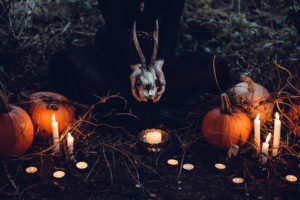Witches and Wellness: What to Make of the Growing Numbers
 Photo by freestocks.org on Unsplash
Photo by freestocks.org on Unsplash On the evening of Saturday, October 20, dozens of people, mainly women, gathered in the back room of an occult bookstore in Brooklyn. Reporters and videographers looked on as a group of witches lit candles, chanted psalms, and slipped names of their hex targets into jars sealed with a combination of grave dirt, sulfur, and urine. Catland Books caters to those who claim to practice witchcraft, and while paganism isn’t new, it’s experiencing a revitalization across America. As author Carmen LaBerge commented regarding Pew research and several surveys out of Trinity College, “There may now be more Americans who identify as practicing witches, 1.5 mil, than there are members of mainline Presbyterianism (PCUSA) 1.4 mil.”
Young people, and especially young women, have begun to turn to paganism and witchcraft in attempt to find identity, forge solidarity, and, sometimes to take political action.
Of course, America’s most famous perception of witches is the cruel trope of the women accused in Salem throughout the late 1600s. However, pop culture depictions of witches and their practices have also captured our imaginations. Most recently, Netflix released a gritty reboot of Sabrina the Teenage Witch, targeted to teens and portraying the title character as a feminist discovering her voice through her magical powers. Ryan Murphy’s American Horror Story: Coven gave witches a snarky, sexy edge, as a coven of descendants of the Salem witches learn to survive in the modern world.
Even the cosmetics chain Sephora got in on the fast-money capitalization of witchcraft, rolling out a “Starter Witch Kit” last month in a partnership with San Francisco fragrance company Pinrose. The $42 kit included fragrances, a tarot deck, a piece of white quartz, and a bundle of white sage. The companies pulled the product following accusations of appropriation by members of the Wiccan community and indigenous cultures across North America. Spiritual fortitude and witchcraft have permeated the self-care and wellness industry—Gwyneth Paltrow’s pseudo-wellness company Goop, for example, offers symbols of New-Age mysticism for sale at outrageous markups, including “wellness oils” at $85.00 per bottle, a $65.00 “She Wolfe” tarot card deck, a $44.00 “Sacred Creators Oracle Set” made up of a guidebook and sixty-seven oracle cards, and, for $85.00, the “Goop Medicine Bag,” which is filled with rocks.
This is not to say that modern witchcraft is solely about self-care tips and tricks.
In fact, one of the community actions bringing witchcraft to the forefront of the public consciousness is the recent trend of group hexes on conservative politicians and other public figures deemed villainous or evil. An anonymous international collective of witches drafted and shared a manifesto in the form of a magical, anti-fascist spell book. When interviewed, one witch explained that “the spells work best when they simultaneously disrupt fascist energies while creating an open channel for healing to take place in marginalized communities.” Witches and wizards alike have cast hexes on Donald Trump since he became president. Describing themselves as activists of the #MagicResistance, they continue to hex the leader of the free world monthly. Witches were hexing Supreme Court Justice Brett Kavanaugh during his confirmation hearings, and they provided helpful instructions online to novice witches following along at home.
The evil curses aren’t even limited to politicians and political figures. On June 7, 2016, a group of witches gathered to cast a hex on Stanford swimmer and rapist Brock Turner.
Lest the reader think that covens of witches are limited to kooky oddballs it’s critical to recognize that witchcraft lives so far in the mainstream that celebrities are comfortable embracing the spiritual practice. Lana Del Ray encouraged her followers to hex Trump and even claimed to have participated in a ritual hex of the president. Spencer Pratt, infamous reality TV villain, dabbled in wizardry, even spending “thousands of dollars on a wizard coach.” Pratt has since shifted his spiritual focus to crystal healing, although he’s held onto his wand (made of rutilated quartz).
This resurgence of witchcraft has given a new voice to people who feel they’ve been limited by systems of oppression, a new opportunity to feel heard. One member of the witchcraft community explained:
Witchcraft is a name given to networks that have survived despite innumerable repressions. The history of fascism is not just the history of fascist repression. It is also the history of resistance. Witchcraft is the practice of building that resistance.
Her voice is echoed by the many other self-proclaimed witches who describe hexes, curses, and other occult practices as a method of political activism, free expression, and self-care. One hex, cast during the final presidential debate of 2016, was meant to convince Donald Trump of the wisdom of dropping out of the race. We can see today just how effective it was.
Many of the women involved in these witchy communities see the practice as a way to practice feminist values and resist a culture of patriarchal oppression. They cite the oppressive nature of other religious traditions as a predominant factor that drew them to paganism, in addition to feeling ostracized or undervalued by society as a whole. While spiritual in nature, Wicca and paganism hold the core value that humans have intrinsic worth. While I’m not convinced of the power of hexes, crystals, or tarot cards, I can certainly agree with the desire to protect those among us who lack power and to recognize the worth of those who hear from society that they have none. If it takes witchcraft to spread that message, then so be it.
I also hope to see all these new witches and wizards practicing political activism and free expression at the ballot box on Tuesday.
